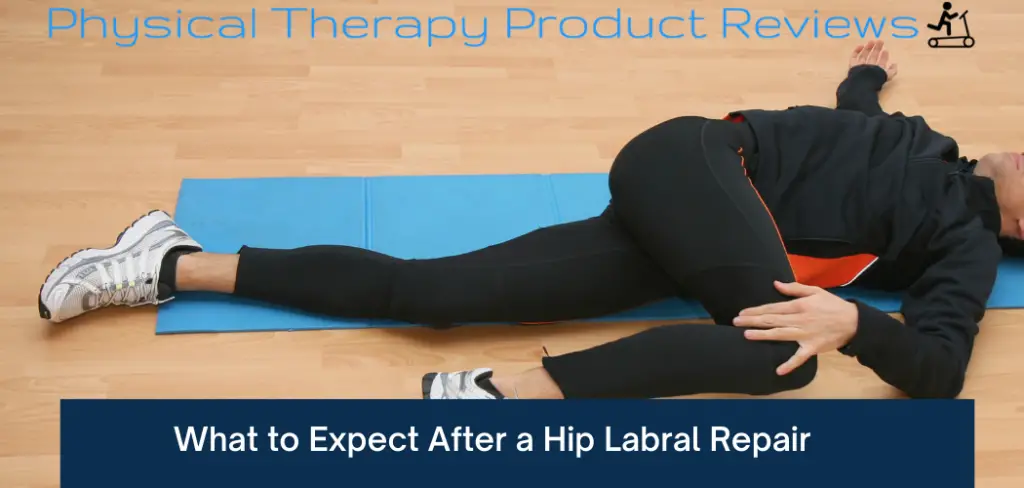If you’re unlucky enough to be reading this, you or someone you know is about to go through a Hip Labral Repair. You’ve probably experienced enough pain and suffering from this injury, and now you just want to know what to expect next.

The most common type of repair is Hip Arthroscopy surgery. It’s a minimally invasive surgery to repair a tear in the labrum, the elastic tissue responsible for stabilizing your hip joint.
Compared to traditional open surgery, a hip labral repair done arthroscopically results in smaller incisions, lower levels of pain, and faster recovery. Whether your doctor recommends arthroscopic or traditional surgery, here’s what you can expect after your Hip Labral Repair.
You’ll Be In Physical Therapy Multiple Times Per Week for 4-6 months
Consider how this physical therapy will affect you socially and financially before surgery.

- Have a big trip planned? The speed and quality of your recovery depend heavily on physical therapy. Skipping sessions shouldn’t even be an option. If you have something big planned, try your best to reschedule. A little sacrifice now ensures a better quality of life long term.
- Have you met your deductible? If this is your first medical expense of the year, take a look at your insurance policy. Until you meet your deductible, you could be responsible for paying 100% of all physical therapy bills.
- Be ready to alter your daily routine. Even when you don’t see your physical therapist, you’ll need to complete the recommended exercises. A speedy and full recovery relies on your dedication to completing these workouts at home.
You’ll be on Crutches for a Minimum of 6 Weeks
Adjust your mobility expectations after surgery. It’s going to be a challenge to walk and drive while you’re recovering. Some things to consider:
- Try to work from home if possible.
- Look into getting a temporary handicap sticker.
- If you’re having surgery on your right leg, try learning how to drive with your left foot. If you’re not comfortable doing that, consider asking a friend or family member for a lift.
Expect to be on crutches for a minimum of six weeks. If you’ve ever used crutches before, you know how important getting the right set is.
These Mobilegs Ultra crutches are designed for comfort and convenience. They have an ergonomic design for a natural wrist angle and an articulated saddle design that pivots as you move. They’re also fully adjustable to meet the needs of adults from 4’9” to 6’4’ weighing up to 300 pounds.
Advice for Hip Labral Surgery
There are Range of Motion Restrictions That You Have to Follow After a Labral Repair
I know you’re anxious to get back on the move, but your hip labral repair won’t provide instant gratification. After surgery, you’ll have some pretty strict range of motion restrictions to follow.
For at least six weeks after surgery, you’ll need to avoid: 
- Hip flexion past 90 degrees: Hip flexion is the movement of bending your torso forward at the hip, or bending your hip to bring your leg up towards your torso.
- External rotation greater than 20 degrees: External rotation occurs when you turn your thigh and knee outward or away from your body.
- Hip extension past neutral: This involves lifting your thigh in a backward motion.
- Abduction greater than 45 degrees: This is the movement of your hip when you move your leg away from the midline of your body. Think of laying on your side and lifting your leg sideways.
It Takes 4-6 Months for Recovery - Pain Can Last Up to A Year
Right now, you might be looking at your Hip Labral repair as the finish line. Unfortunately, you’ve still got a long road ahead after surgery.
Recovering from your Hip Labral repair takes four to six months of physical therapy, and it can take nine to twelve months for you to get back to 100%. Pain from your hip labral injury may last up to a year after surgery.
I know this sounds daunting, but all you can do is focus on getting to the real finish line. Stick to your physical therapy plan, complete the at-home workouts, and don’t try to do too much too fast.

Here’s a loose outline of what to expect. Remember, everyone heals differently so your progress won’t match this exactly.
- 0-4 Weeks Post Surgery: Begin mobility and exercises and stretching. The main goals at this time are to reduce pain and swelling, improve mobility, and start restoring normal gait patterns while staying within your comfort zone.
- 4-8 Weeks Post Surgery: By this time, you should be more comfortable moving your hip joint. You might also experience less pain and a greater range of motion. Your physical therapist will start to encourage you to walk more and more until you have worked up to a mile. You can also begin swimming and elliptical training, depending on your level of comfort and pain.
- 8-12 Weeks Post Surgery: The focus during this time is building strength and increasing endurance. While you won’t be ready for high-impact activities, you should be ready for some weight training.
- 12-16 Weeks Post-Surgery: You can (literally) jump for joy at this point. Your hip joint should be able to support you in more high-impact activities like jumping and running.
- 4 Months Post Surgery and Beyond: If you’ve followed your physical therapist’s recommendations and continued at-home workouts, you should be ready to resume living your regular life. It can take up to 9 months for you to feel 100%, but at the 4-month mark, you’re getting closer.

Mild Complications are Normal
As with every surgery, complications and long-lasting negative effects are possible. More common complications include:
- Persistent numbness in the lateral hip
- Stiffness in the hip joint, especially in the morning
- Poor reactions to anesthesia and/or pain medication
- Pain in the hip lasting six months or more
- Deep Vein Thrombosis, or a blood clot in the veins. Wear compression socks after surgery to help reduce the risk of DVT.
Inform Your Way to a Speedy Recovery
It’s important to feel in control and prepared when heading into surgery. If you have any other questions about your Hip Labral Repair or recovery, be sure to follow up with your doctor. It’s normal to feel nervous about your surgery, knowing what to expect during and after helps keep your anxiety at bay.
Works Referenced:
Other Great Rehab Related Articles
GLP Weight Loss and Back Health: Effective Strategies and Insights
How to Stay Active After Cervical Fractures: Expert Tips and Advice
Dealing with Painful Stairs After Ankle Replacement Surgery
Walking After a Total Ankle Replacement: Tips for a Successful Recovery
Exercises While Non-Weight Bearing After Ankle Replacement: Elevation, AROM, Leg Raises, and More
Ankle Pain with Stairs: Causes and Home Treatment Options
Disclaimer: The information provided in this post is for educational purposes only. This is not a substitute for a medical appointment. Please refer to your physician before starting any exercise program.







